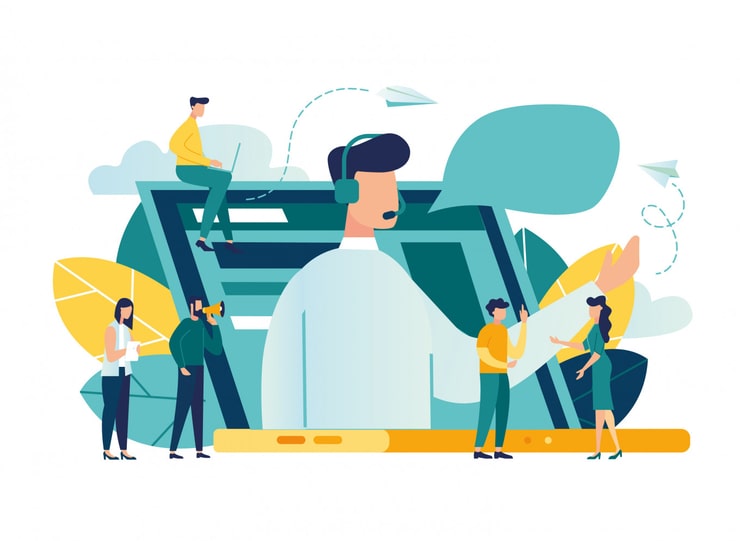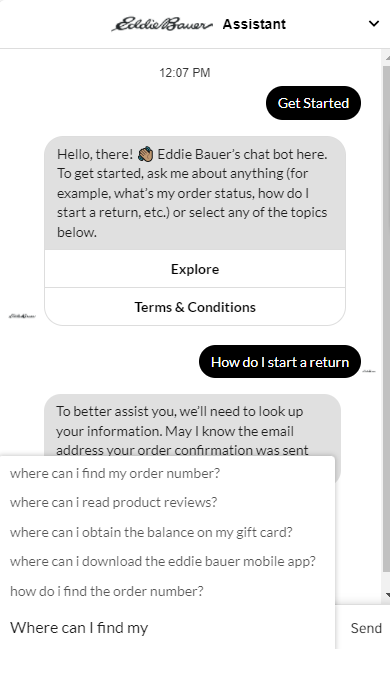
Consumers today expect more from brands than ever before.
They gravitate towards brands that are invested in their wants and needs and are committed to providing a first-class experience time and time again.
Shoppers today can afford to have impossibly high expectations because, if they don’t get their needs met by one brand, there are plenty of others out there who will try harder.
As a result, proactive customer service is now vital.
Doing something for your customers before they even know they need it can cement you as their go-to brand regardless of whether you’re the cheapest or coolest option available.
In this post, we'll discuss:
- Proactive customer service definition
- Why businesses should care about being proactive when supporting customers
- The benefits of proactive customer service
- How to take a proactive approach to customer service
What Is Proactive Customer Service?
Proactive customer service means letting a customer know in advance about a problem and sharing the solution you’re putting in place to relieve the inconvenience.
An example might be a waiter filling up a diner’s glass before it’s empty, or a retail brand calling up a buyer to let them know their delivery is delayed and when they can expect it instead. Pre-empting pain points like this means users don’t have to go out of their way to dig for information.
To put it simply, it’s all about who makes the first move:
- Reactive customer service is when a customer has to reach to a company representative
- Proactive customer service is when you make the first move
Erring on the side of proactive and putting your customers first will not only improve your brand’s reputation but can also boost your bottom line. In fact, 60% of brands reported an increase in sales when they improve customer service.
Why Get Proactive With Customer Support?
We’re living in customer-centric times.
Brands that put their customers at the center of everything they do see better results.
It’s why personalization is so important and why consumers identify more with brands that believe in the same issues as them.
Consumers want a connection with the businesses they give their money to, but they also want to feel special - and they’ve made their preference for proactive customer support very clear.
Essentially, by being proactive you’re showing that your business is customer-focused and is always striving to deliver an amazing customer experience.
This in turn helps ensure customers feel special since the focus is on what your business can do for them.
In a study by inContact, consumers had a positive view of proactive support.
87% of people surveyed said they were happy to be contacted proactively by companies regarding customer service issues, and 75% who had a pleasant surprise or positive experience with an incoming call reported a positive change in their perception of the company calling them.
When it comes to customer service best practices, if you’re not running a proactive approach to supporting customers, you might be missing out.
The Benefits of Proactive Customer Service
Being proactive when it comes to how your business approaches customer service has many benefits such as:
Avoid Turning Problems Into Painful Pain Points
Taking a proactive approach to customer service means you can catch niggling problems before they grow into big, impossible-to-overcome pain points.
If the diner in our restaurant example above didn’t get more water they might have become increasingly thirsty and uncomfortable, causing them to get distracted and have a bad experience.
Save Customers a Huge Amount of Time
Proactive customer service means anticipating customer needs and actively reaching out with a solution, whether that’s by communicating a potential problem that’s cropped up, or allowing customers to self-service their issue.
Reaching out before a customer is often even aware they have a problem saves them valuable time and energy.
Essentially, it helps them tap into the value your business is offering that much quicker.
Build Customer Loyalty (and Retain Loyal Customers)
Customer churn is a huge problem with brands these days. With so much choice available, it’s harder than ever for consumers to remain loyal - especially if a brand lets them down in some way.
Implementing proactive customer service will allow you to build loyalty through amazing experiences.
In fact, a report by Enkata found that taking initiative in the support you provide for customers can increase customer retention rates by 3-5%.
That might not seem like a lot, but over time it can add up to include many more customers and a dramatic increase in revenue.
Get Valuable Customer Feedback and Make Better Decisions
The tools you use to monitor customer activity provide a valuable source of feedback - a vital part of any business that wants to consistently improve.
You can use this customer feedback to make more informed product decisions and create resources that will solve common problems without needing to involve an agent.
Lower the Need for Support Calls
A reactive customer service model needs agents on hand at all times - after all, who knows when a customer will face a problem they need urgent help with?
On the flipside, a proactive approach can help you identify common issues and resolve them before they become actual problems.
This results in a lower number of tickets and frees up your agents to work on other parts of the business.
Get Ahead of Customer Conversations
It’s a given that customers will talk about your brand to their friends and family behind closed doors, but they’ll also take to social media to talk about your brand too - regardless of whether their talk is good or bad.
Implementing proactive customer service means you can get involved in the conversation and engage with your customers in a way that puts your business in the most favorable light and helps businesses better control the narrative around their brand image.
This is particularly important when you learn that a lot of brand sentiment is gathered via social channels, as it helps keep large scale issues contained.
Create Advocates and Brand Ambassadors
Brand advocates will shout about your products and services from the rooftops. This is invaluable in an age where consumers prefer to listen to the opinions of their peers rather than advertising messages.
Proactive customer service offers you the chance to not only reduce unhappy customers, but turn them into brand advocates in the process.
According to research, happy customers will tell at least three people about their experience.
How to Deliver Proactive Customer Service
Now that we've hopefully convinced you of how beneficial it is for your business to be proactive with its customer service initiatives, let's actually discuss what steps you can take to go from a reactive business to a proactive one.
1. Get to Know Your Customers
It sounds like basic advice, but getting to know your customers provides a base from which you can grow your ability to provide proactive customer service.
To deliver a great experience, you have to know what struggles your customers face, what challenges they can’t get past, and what drives them. You can do this by:
- Paying attention and listening to their queries via social media, on dedicated forums, and in relevant feedback and reviews
- Reaching out to customers who mention your brand on social media - regardless of whether the conversation is in a good or bad context
- Digging into common customer complaints and problems that crop up in your customer service department
If you’re not paying attention to what customers are saying about you online, you’re missing out on key opportunities.

Image Caption: Example of UPS listening and responding to positive feedback on social media. UPS can potentially use this feedback to train delivery drivers to try hiding expensive-looking packages. Doing so is a proactive service approach that can limit customer packages from being stolen.
By better understanding their struggles and dreams, you can address their most important needs and increase customer satisfaction levels.
2. Gather Feedback
Feedback is one of the most valuable tools you can have in your business. It allows you to identify common customer pain points and fix them before they become a problem.
You can gather feedback by:
- Including a feedback form on your website that is served to customers after they take a specific action
- Sending a survey to past customers using a tool like SurveyMonkey, TypeForm, or Google Forms
- Interviewing a handful of your best customers and asking them how you can improve your product and overcome their objections
- Checking your messages and mentions on Facebook and Twitter for feedback on your products and services
- Reviewing your helpdesk tickets and knowledge base analytics to analyze the most common questions
When you gather feedback, you’ll start to see trends that crop up. These might be a similar slew of objections pre-purchasers have, or it might be a common complaint that keeps cropping up from your customers.
This will give you the insight you need to put proactive customer service activities in place that actually tackle real-life issues your customers have.
3. Empower Employees
Ensuring your employees are aware and have access to resources and information they need to proactively help consumers will make the process seamless.
This will help them instinctively guide consumers to the right solution before they even know they need help, and it will arm them with the tools they need to provide exceptional customer service.
There are a couple of ways you can make sure everyone is in the know, including:
- Setting up an internal knowledge base or communication space where employees can search for relevant materials or ask for the answers they need to help consumers
- Providing training on proactive customer service and the benefits it has for both employees and customers
4. Create Content and Resources That Tie Into the Feedback
When you are aware of the most common problems and complaints your customers have, you can create resources that proactively tackle them.
For example, you can create a knowledge base or an FAQ page on your site that customers can search through to find answers to their questions.
According to research, 91% of consumers say they’d be willing to use online self-service knowledge sources if they were available, while 67% of customers prefer self-service over speaking to a company representative.
This saves them sending a ticket to an agent and waiting on a reply that could take hours or even days.
Start creating helpful resources by:
- Identifying common questions your audience have (use the research into your customers and any feedback you’ve gathered for this)
- Determining the most efficient solution to the problem
- Choosing the most knowledgeable team member to create a resource that outlines the solution
- Deciding the best format for the information to be presented in (this might be a video if it’s a complex tutorial or simply an FAQ-style resource that provides short, to-the-point answers)
- Creating the resource and testing it out with a handful of customers
- Directing future customers with similar problems to the resource, or making it readily available for customers to search
Resources are a common way to relieve immediate problems your customers might have. They can read them or watch them in their own time without the need to reach out and wait for a response.
GetFit includes a knowledge center on its site that is searchable. It has a selection of popular topics and common questions, as well as a search bar that allows customers to enter their own problems.
5. Follow Up Low Customer Satisfaction Survey Scores Immediately
The most basic and, therefore, one of the easiest forms of proactive customer service is following up low satisfaction scores immediately.
If a customer services you a one-star review, you can reach out to them right away to uncover their main problems.
From there, you can determine whether to send an apology message if it was a one-off occurrence, or follow-up with a phone call and another resource that will help them navigate the problem better in the future.
This brand asks customers how easy it was to complete an order. They can follow up immediately with anyone who responded with a less-than-positive answer.
6. Pin Point Key Moments in the Customer Journey
A lot of proactive customer service is about anticipating customer needs and providing an answer before a question is even asked (i.e. anticipating a diner needs more water when their supply is running low).
The more you get to know your customers and the journey they take with your business, the better equipped you’ll be to serve them the right information at the right time.
You can use this knowledge to create rules or pinpoint certain moments throughout the customer journey when it’s best to intervene and pre-empt offering a solution.
7. Be Honest and Transparent
Consumers today crave honest and authentic connections with the brands they buy from.
Making customers aware of a problem as soon as it happens will score you points with your customers - but you have to be open and honest about the problem from the start.
You can do this by:
- Informing customers of the issue and offering an apology before they get in touch with you
- Offering a discount or a refund if the action you take to fix the problem doesn’t quite satisfy their needs
- Updating customers on the steps you’re taking to solve their problem and reassuring them that the issue won’t happen again
- Making sure customers know exactly who to contact and how to contact them if they have further questions or feedback
Trying to hide a problem is one of the worst things you can do. If disaster strikes, get ahead of the game and reach out to your customers before they even realize something has gone wrong.
8. Build Customer Service Into Company Culture
For proactive customer service to thrive in your business, you need to create a customer service policy to help with making this business mindset a part of your overall customer service vision and company culture.
Putting your customers first should be a priority, and everything you do should revolve around the wants and needs of your buyers.
You can bring everything you’ve learned together in this guide to create an enjoyable experience for your customers that is imbued into your brand:
- Get to know your customers and their wants and needs
- Determine their main pain points and common questions they have
- Create resources and action plans to tackle their problems head-on and proactively
- Continue to be authentic and honest
9. Provide Self-Service Opportunities
While it may seem difficult to believe, customers aren't necessarily looking to speak directly with a representative of your company when a probe arises. In fact, a study by the Harvard Business School found that 81% of customers look to solve an issue on their own before deciding to reach out to a customer service representative. Another study found similar results, with over 70% of respondents stating they would prefer the ability to solve their customer service issues on their own.
The moral of these studies? Providing cost-effective, seamless self-service is not only a solid plan for pleasing your customers, but it is also a proactive way of providing support to your customers.
By offering a self-serve portal, you allow customers to proactively find answers to their questions as well as solutions to their problems when it's convenient for them.

One of the best ways to create a self-serve portal is through the use of knowledge base software. By creating a customer-service knowledge base, your business to put helpful content in front of its customers—all without ever needing to contact you and open a customer service ticket.
Additionally, you'll want to make use of chatbot software which, when powered by a knowledge base software, can be used as a proactive customer support tool that answers customer support questions as well as point customers in the right direction for more in-depth solutions. Not only that, but chatbots can help with taking in user information which can then be used by your support team to reach out to customers in need.

Unbeatable Customer Service Gives You a Competitive Edge
Customers actively seek out brands that provide an exceptional customer service experience - being proactive with your customer service will help in creating a better experience for your customers.
The businesses that do find ways to provide proactive customer service become brands that customers trust and become loyal to, and therefore keep going back to for more.
If you haven’t already, consider making the switch from a reactive company to one that puts its customers first by being proactive when supporting customers.
This will help you can get ahead of the conversation and gain a competitive edge.
Get a 14-day free trial and see how Helpjuice's knowledge base software can help you be proactive when it comes to customer service.





